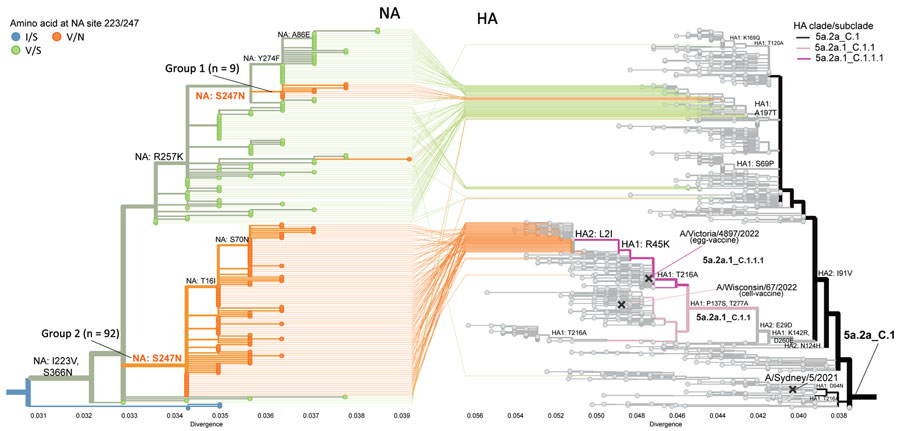Volume 30, Number 7—July 2024
Dispatch
Multicountry Spread of Influenza A(H1N1)pdm09 Viruses with Reduced Oseltamivir Inhibition, May 2023–February 2024
Figure 2

Figure 2. Tanglegram showing influenza A(H1N1)pdm09 phylogenies for NA gene (left) and HA gene (right) from susceptibility surveillance conducted by the Centers for Disease Control and Prevention and analysis of available sequences (GISAID EpiFlu, https://www.gisaid.org, accessed March 11, 2024), May 2023–February 2024. The NA-HA tangle tree was constructed by using Nextclade (8) and visualized by Auspice (https://auspice.us). NA phylogenetic tree is zoomed to show only subclade C.5.3 with 2 groups of dual I223V + S247N mutants. All dual mutant viruses shared >6 NA amino acid substitutions (V13I, S200N, I223V, S247N, L339S, S366N) compared with vaccine prototype virus A/Wisconsin/67/2022. Group 1 shared an additional substitution R257K not observed in group 2. Tree tips colored in blue indicate viruses with wild type amino acids at residues 223 and 247 (i.e., I223 and S247); green shows single I223V mutants; and orange shows dual mutants. Small group 1 with 9 dual mutants and large group 2 with 92 dual mutants are indicated. The NA sequence and corresponding HA of each virus are connected by lines. Group 1 dual mutants have HA 5a.2a_C.1. Only 2 group 2 dual mutants (A/British Columbia/PHL1108/2023 collected in May 2023 and A/France/IDF-RELAB-IPP24993/2023 collected in October 2023) have HA 5a.2a_C.1; remaining group 2 dual mutants shared HA 5a.2a.1_C.1.1.1. HA 5a.2a_C.1 is represented by A/Sydney/5/2021, the Southern Hemisphere 2023 vaccine egg/cell prototype virus. HA 5a.2a.1_C.1.1.1 is represented by A/Victoria/4897/2022, the Northern Hemisphere 2023–2024 vaccine egg prototype virus. The Northern Hemisphere 2023–2024 vaccine cell prototype virus, A/Wisconsin/67/2022, represents HA 5a.2a.1_C.1.1. HA, hemagglutinin; NA, neuraminidase.
1These authors contributed equally to this article.